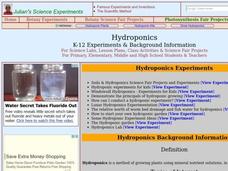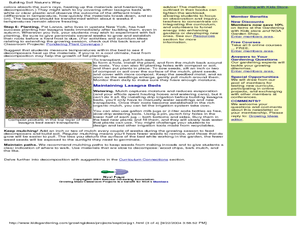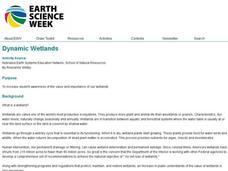Baylor College
Water in Your Body
Do you know how much water you have had in the last 24 hours? Do you know how much your body needs? For this hands-on activity, your class members will estimate how much water our bodies lose each day by filling and emptying one-liter...
Virginia Department of Education
Physical and Chemical Properties of Water
How can you effectively provide detailed concepts of water properties to your high school class in a way they find exciting and challenging at the same time? By letting them play, of course! Through a variety of...
Curated OER
Food And Energy
The different nutrients needed by the body and the reasons for each are presented very clearly in this powerpoint. There are 2 review questions at the end, but this PowerPoint is essentially comprised of facts and examples to...
Towson University
The Crucial Concentration
Which sports drink provides the best pick-me-up after the big game or grueling workout? It may not be the one you'd think! Food science is the focus in a surprising lab activity. Pupils use colorimetry to determine the amount of protein,...
Curated OER
Non-Nutrients: Fiber and Water
Students discuss how much fiber and water a person needs each day. They use beans soaked in water to show the benefits of water to the human body. They also learn the health benefits to eating healthy.
Curated OER
Essential Nutrients - Daily Guides
List the recommended dietary guidelines and explain their function and implementation. (The guidelines are listed below) National Standards 14.3.1 Aim for fitness Aim for a healthy weight Be physically active each day
Curated OER
Building a Better Body
Fourth graders investigate the six essential nutrients. They read a handout, discuss the six nutrients, and construct a sandwich using ingredients that belong to the nutrient groups.
Curated OER
Health and Growth
Students recognize that living things need food and water. In this health and growth lesson, students identify foods that are better for health and growth. Students sing a song and complete a worksheet. Students understand that...
Curated OER
Water
Students examine water, its function and how much you should consume. In this water lesson students study water and why it is important, how much you should drink and what its functions are in your body.
Curated OER
How to Grow a Sunflower Plant
Students explore botany by conducting a sunflower growth experiment. In this plant life lesson, students identify the anatomy of a sunflower plant and the essential nutrients it requires to grow. Students utilize compost, soil, garden...
Curated OER
Water Quality Monitoring
Students comprehend the four parameters of water quality. They perform tests for salinity, dissolved oxygen, pH and clarity or turbidity. Students comprehend why scientists and environmental managers monitor water uality and aquatic...
Curated OER
Go With the Energy Flow
Learners explore energy and nutrient flow. In this science instructional activity, students diagram the flow of energy through food chains and food webs. Learners discuss the importance of energy flow in Earth's ecosystems.
Curated OER
The Root Show
Students investigate plant roots. In this plant lesson, students discover the function and structure of plant roots. Students plant a plant in a milk carton with a clear section cut out in order to observe the roots of the plant.
Curated OER
Move To a Healthier Aquatic Balance
Fourth graders examine aquatic orgnaisms and how enviromental chages affect them. This factors include: temperature, Ph, oxygen, nutrients, and pollutants. They also explore habitat quality (erosion). Students compile data and create...
Curated OER
ABOUT ALL YOU CAN EAT: Superfoods
Young scholars trace back through time to see how the nutritional value of food consumed was enhanced. In this nutrients lesson students complete several activities that show the mass of food, and its PH value.
Curated OER
Oil Spill
Students explore an important role of environmental engineers by studying the Exxon Valdez oil spill. They experiment with different strategies in order to clean up their own manufactured oil spill.
Curated OER
Non-nutrients: Fiber and Water
Students will identify the sources and function of carbohydrates and fiber and apply appropriate food preparation techniques.
Curated OER
Hydroponics
Students examine how to grow plants using a hydroponic system. In this hydroponics lesson students identify the advantages and disadvantages of growing plants hydrologically.
Curated OER
Classroom Aquaponics: Exploring Nitrogen Cycling in a Closed System
Students investigate nutrient cycling in a simplified desktop ecosystem involving aquarium and hydro-ponically grown plants. They set up an aquarium with 10 gallons of water at least a week before the lab is planned and place...
Curated OER
Building Soil Nature's Way: Exploring decomposition and soil health
Young scholars explore decomposition and soil health by creating their own garden. For this agriculture lesson, students build a "lasagna garden" with organic matter found in the area and plant perennials native to their region....
Curated OER
Week 3: Pollution Source and Effects
Lab groups set up an experiment to observe what happens over time in collected pond water when fertilizer, representing pollution, is added. This website does not include student lab sheets, but background information, materials, and...
NOAA
The Dead Zone
The fifth installment of a 23-part NOAA Enrichment in Marine sciences and Oceanography (NEMO) program defines dead zones and how they form. Pupils then examine data from the Gulf of Mexico to determine dead zone formation.
Curated OER
Hunger and Malnutrition
Young scholars recognize that our bodies cannot function without certain essential foods. In this hunger and malnutrition lesson, students become familiar with the problems associated with malnutrition such as medical problems, problems...
Curated OER
Dynamic Wetlands
High schoolers construct and observe a model of two different types of wetlands. In this wetlands lesson, students create a model of a wetland with constant drainage and a wetland that maintains a well-saturated soil. High schoolers...























